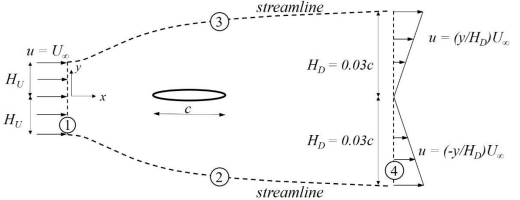Aerospace Engineering Gate Yearwise
Aerospace Gate 2024
Aerospace Gate 2023
Aerospace Gate 2022
Aerospace Gate 2021
Aerospace Gate 2020
Aerospace Gate 2019
Aerospace Gate 2018
Aerospace Gate 2017
Aerospace Gate 2016
Aerospace Gate 2015
Aerospace Gate 2014
Aerospace Gate 2013
Aerospace Gate 2012
Aerospace Gate 2011
Aerospace Gate 2010
Aerospace Gate 2009
Aerospace Engineering GATE 2024 Questions with Answer
Ques 1 Aerodynamics
Which one of the following figures represents the drag polar of a general aviation aircraft?
Ques 2 Aerodynamics
Using thin airfoil theory, the lift coefficient of a NACA 0012 airfoil placed at 5° angle of attack in a uniform flow is _______ (rounded off to 2 decimal places).
1 is the correct answer.
Ques 3 Aerodynamics
As per the International Standard Atmosphere model, which one of the following options about density variation with increase in altitude in the isothermal layer is correct?
Ques 4 Aerodynamics
The figure (not to scale) shows a control volume to estimate the forces on the airfoil with elliptic cross-section. Surfaces 2 and 3 are streamlines. Velocity profiles are measured at the upstream end (surface 1) and at the downstream end (surface 4) of the control volume. The drag coefficient for the airfoil is defined as Cd = D/(1/2 * ρ * U∞2 * c), where D is the drag force on the airfoil per unit span and ρ is the density of the air. The static pressure, p∞, is constant over the entire surface of the control volume. Assuming the flow to be incompressible, two-dimensional, and steady, the Cd for the airfoil is _______ (rounded off to 3 decimal places).

a is the correct answer.
Ques 5 Aerodynamics
It is desired to estimate the aerodynamic drag, D, on a car traveling at a speed of 30 m/s. A one-third scale model of the car is tested in a wind tunnel following the principles of dynamic similarity. The drag on the scaled model is measured to be Dm. The ratio D/Dm is _______ (rounded off to 1 decimal place).
1 is the correct answer.
Ques 6 Aircraft Propulsion
An aircraft with a turbojet engine is flying with 250 m/s speed at an altitude where the density of air is 1 kg/m3. The inlet area of the engine is 1 m2. The average velocity of the exhaust gases at the exit of the nozzle, with respect to the aircraft, is 550 m/s. Assume the engine exit pressure is equal to the ambient pressure and the fuel-air ratio is negligible. The uninstalled thrust produced by the engine at these conditions is _______ N (rounded off to the nearest integer).
1 is the correct answer.
Ques 7 Aircraft Propulsion
A multistage axial compressor, with an overall isentropic efficiency of 0.83, is used to compress air at a stagnation temperature of 300 K through a pressure ratio of 10:1. Each stage of the compressor is similar, and the stagnation temperature rise across each compressor stage is 20 K. Assume Cp = 1005 J/kg K and γ = 1.4 for air. How many stages are there in the compressor?
Ques 8 Aircraft Propulsion
An aircraft with a turbojet engine is flying at 250 m/s. The uninstalled thrust produced by the engine is 60000 N. The heating value of the fuel is 44 x 106 J/kg. The engine has a thermal efficiency of 35% while burning the fuel at a rate of 3 kg/s. Assume the engine exit pressure to be equal to the ambient pressure. What is the propulsion efficiency of the engine under these conditions (in percentage)?
Ques 9 Aircraft Propulsion
Which of the following statements is/are TRUE for an axial turbine?
Ques 10 Aircraft Propulsion
Which of the following statements is/are TRUE for a single-stage axial compressor?
Ques 11 Aircraft Propulsion
A chemical rocket with an ideally expanded flow through the nozzle produces 5 x 106 N thrust at sea level. The specific impulse of the rocket is 200 s and acceleration due to gravity at sea level is 9.8 m/s2. The propellant mass flow rate out of the rocket nozzle is _______ kg/s (rounded off to the nearest integer).
a is the correct answer.
Ques 12 Aircraft Propulsion
A centrifugal compressor is designed to operate with air. At the leading edge of the tip of the inducer (eye of the impeller), the blade angle is 45° and the relative Mach number is 1.0. The stagnation temperature of the incoming air is 300 K. Consider γ = 1.4. Neglect pre-whirl and slip. The inducer tip speed is _______ m/s (rounded off to the nearest integer).
a is the correct answer.
Ques 13 Flight Mechanics
In a conventional configuration airplane, the rudder can be used:

Total Unique Visitors